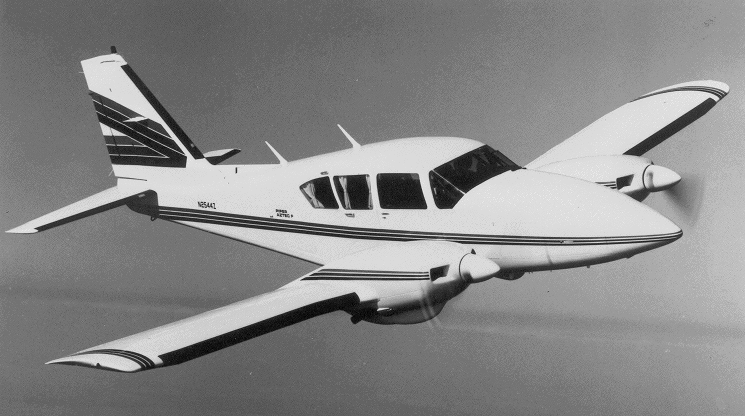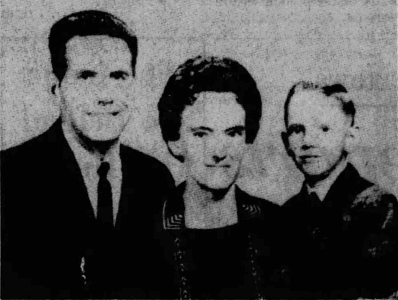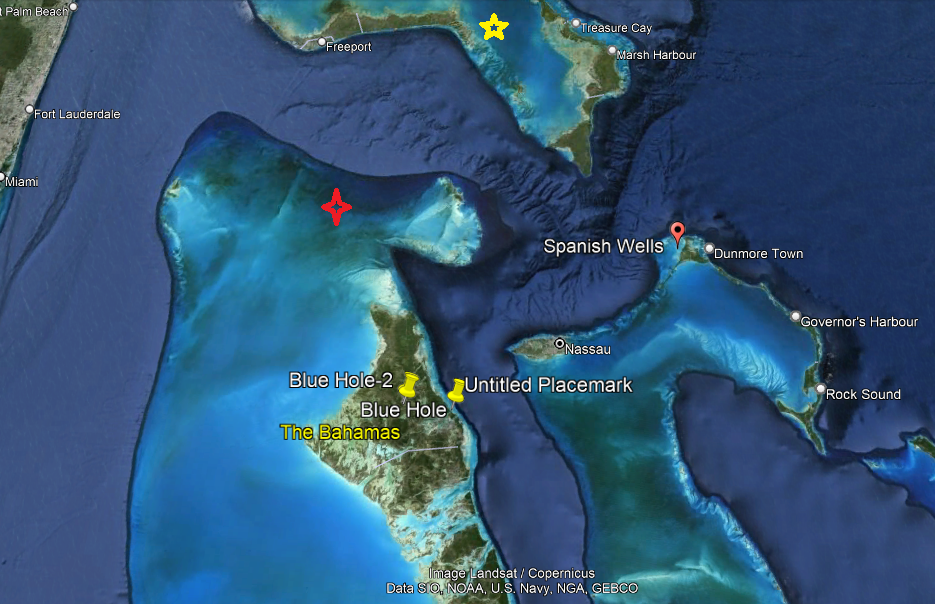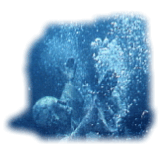|
“An incident somewhat reminiscent of the confusion recorded by the pilots of Flight 19 occurred in the case of an SOS from a private plane proceeding to Nassau, Bahamas, but flying in the vicinity of Great Abaco Island. Although the morning weather was excellent, the pilot seemed to be flying through fog and was unable to give his position or even see the islands below him, in spite of the clear visibility apparent to other observers in the surrounding area. In this case the plane did not completely vanish, as a part of one wing was later found floating in the sea.”
Charles Berlitz truly danced around this controversial incident in his 1974 bestseller The Bermuda Triangle. He won’t mention the pilot’s name or even the date, but nevertheless he reflects details about the plane’s course and even the pilot’s last radio communication. In his chapter “Is There a Logical Explanation?” he speaks with Athley Gamber, CEO of Red Aircraft. “Athley Gamber, an attractive brunette, and a charming example of a vital, successful woman executive, is the widow of a pilot who disappeared on a flight between Fort Lauderdale and the Bahamas.” Again, no name. He presents her as in cautious agreement with the official Coast Guard opinion that weather and pilot error can account for the disappearances. She doesn’t believe anything sinister is unique to the area. She is convinced that man cannot cope with nature.
For those in-the-know it becomes apparent why Berlitz handled the incident so carefully. He is, of course, speaking of Red Gamber. He was a highly praised pilot. His disappearance in 1968 was widely covered in the newspapers. Not only was he popular, he was ferrying to the Bahamas a popular missionary family— Rev. Talmadge  Butler, his wife and their 11 year old son, in his Piper Aztec. Butler, his wife and their 11 year old son, in his Piper Aztec.
Reading between the lines in the newspapers, it is obvious something unusual had happened with the flight, but those interviewed from Red Aircraft also seem noncommittal as to what happened, probably because they couldn’t understand the bits of information and reports coming back. From Berlitz’s interview with Athley Gamber it is clear she believed some form of weather was responsible. “She is of the opinion that the reason that many pilots have not sent a Mayday or SOS was ‘that they had no idea that they were in trouble . . .’” This perhaps is a compromised theory based on strongly differing opinions about what actually happened in her husband’s disappearance.
I have shied away from delving into old cases because I didn’t think readers would be too interested. But there are a few listed in the litanies of old books or sketchily referred to, as in the above, which deserve a far more detailed account. And as in the above, some I think constitute significant rungs in the ladders that build acceptable theory.
Let’s look at the details of this hitherto shadowy case.
Fort Lauderdale, the morning of July 7, 1968 (7:15 a.m.), Clayton “Red” Gamber took off in his Piper Aztec. His passengers were friends Rev. Talmadge Butler, his wife Marg, and their 11 year old son Steve. Their destination was Rock Sound, Eleuthera Island, where Rev. Butler had a Sunday speaking engagement. Red wasn’t going to miss a chance to fly with his friend, Tal Butler. There was only a few years difference between them— Red was 43 and Butler 39— and they had been friends for years. Both were aircraft junkies. Butler was not just a pilot, he was also an expert mechanic.
Red was always happy to join Tal on his trips between Miami and the Bahamas. Before going to Africa, Tal Butler had been his denomination’s superintendent for the Bahamas. He had spent 10 years in the archipelago, and like Red he had survived more than one harrowing flight, including walking away with only a scratch on his wrist after a totaled landing. totaled landing.
Newspaper photo of the Butlers.
Both were also alike in being cautious pilots. They weren’t barnstormers or daredevils. Red also kept his Aztec in tiptop condition. He was, in fact, a pillar of the aircraft community.
From the vantage of the coast, the conditions were perfect this early Sunday morning.
About 8:30 a.m. Gamber contacted Nassau. The traffic controllers maintain the call was routine. Gamber had filed a flight plan to Nassau and was making sure all was clear for a landing. He was only about 70 miles northwest.
The next time Gamber was overheard, it was at 9:25 a.m. A Pan Am pilot received a call from him. Gamber spoke with him, and here the newspapers are nebulous. Gamber asked the pilot of the Pan Am flight to switch frequencies in order to talk to him.
There is a problem immediately apparent here for anybody who knows the routes and the speed of a twin-engine Aztec. By 9:25 a.m. Gamber should have already landed at Nassau.
However, between Bimini and Nassau there was a squall line. Gamber was a careful pilot, so was Butler. And we must assume both were taking turns flying. Standard procedure is to go around the squall line. We must assume this is what they did, thus explaining why they hadn’t landed at Nassau. If they had tried to inform Nassau, the message had never been picked up.
When the plane failed to arrive at Nassau or its ultimate destination of Rock Sound, contradictory statements were made to the press. The Coast Guard admitted there was “a small squall line” between Bimini and Nassau, adding: “he would have hit it about 9:30 a.m.” when in reality he should have long passed it and been at Nassau. The Coast Guard spokesman, knowing Gamber’s and Butler’s flying talents, speculated they may have landed on another island somewhere.
At present, 3 Guard Guard airplanes, a Navy plane, and an Air Force plane were searching the area between Great Isaacs Light and Nassau. That’s all they could spare. Another aircraft, a Cessna 180, had disappeared about 30 miles off West Palm Beach, after having left West End, Grand Bahama. More search units were busy trying to find it and the two men aboard.
Two disappearances were disturbing. What had happened?
Red knew the area well. He had first come to Fort Lauderdale in 1952 as a service manager for Sunny South Aircraft. Soon he and Al Harp formed Red Aircraft and took up business in the northeast corner of Fort Lauderdale International. After Harp died in an airplane crash in Texas (1956) Red remained as sole owner. Al’s widow, Frances, would remain as secretary.
As the search continues, the reader must remember this. Athley Gamber was anxiously awaiting news of her husband while Frances nearby could give little consolation.
County Airports Director, Lee Wagener, spoke: “Gamber was an excellent pilot. It’s the weather. That’s probably what nailed him.” He couldn’t believe there had been a problem with the plane. “Red never took an airplane out that wasn’t in perfect condition.”
County erosion engineer Duncan Britt was next. He too was a flying friend. “He’s the best— something must have happened to the plane.”
Praises were heaped upon Butler as well by his missionary peers. One in particular was Reverend Carl Thompson. He clarified that the Butlers had stayed with him for two weeks. This was the end of their year long furlough. They were preparing to return to Africa for their 3rd missionary term in Sinegal. Before they left, however, Butler had scheduled three speaking engagements in the Bahamas. Since Red was a long time friend, he had quickly offered to take Butler to the 3 Sunday meetings— at Rock Sound, Nassau, and Spanish Wells. The reader can consult the map below to see how much flying was planned.
It is not surprising with Red Gamber’s reputation he had the Aztec serviced and in tiptop shape.
Rev. Carl Thompson praised Butler: “He had a plane in Africa where the fuel line kept clogging up and he’d drop down in the plain area in the middle of nowhere and fix it. It kept clogging up and he kept making those landings. Once he hit a rock coming in. Nothing addles him. He’s just as cool.” He finally opted: “It’s the weather. That’s the problem.”
“Both men were excellent pilots. They wouldn’t have become emotional. Neither of them would have barreled through this weather. Both were very careful pilots. We feel almost positive that they went north.”
The above dichotomy reveals the confusion of those on the ground. Going north to skirt Grand Bahama, then fly south along Great Abaco would bring the Aztec to Nassau or north Eleuthera. They wouldn’t touch the “small squall line.” Therefore the weather would be irrelevant to the plane’s fate. But then why did they disappear? No one really knew what had happened. Thus the searchers were still overflying the sea and islands between Andros and Nassau.
Two days later hope was still being held out. One of Red’s employees, Ernie Holcomb, declared: “I know a hundred places where they could have set down.”
By July 11, the Coast Guard held out no more hope. They suspended their search. Nothing was found. That morning 7 aircraft took off from Fort Lauderdale International, all piloted by and filled with Red Aircraft employees. A collective 28 persons were aboard to help search. Ernie Holcomb declared: “We will search until we find something— or until our people are convinced that they’ve covered everything they possibly can.”
The Coast Guard admitted that pressure had been applied to continue the search, but Holcomb clarified quickly it had not come from Red Aircraft. He declared they believed they had “done a real fine job.” Holcomb outlined their objective— to fly in the area of Andros and the Berry Islands. “There’s a good possibility they’re on an island somewhere— there are many of them out there.”
The disappearance of Red Gamber and the Butlers had so captivated the area that many other private aircraft were out there searching as well, all volunteers who were friends of the Gambers and Butlers.
This did not alter the fact there were few clues. If the Aztec landed on the Berry Islands then it hadn’t detoured north to go around the squall line. But why hadn’t Red contacted Nassau? No one tried to explain anything. Opinions merely tick-tocked between maybe the weather or a mechanical problem. For some reason, they wanted to believe that Red had landed somewhere on course.
It was a former employee with his own air service who acted upon the information correctly. Orville Tosch, now owner of Tropic Air Service, had searched north of the course. Twelve days after Gamber and the Butlers had vanished he sighted something floating off the east end of Grand Bahama. He landed, rented a boat and went out and retrieved it. It was the wing tip of the Aztec. He was sure of it. Soon Jim Norwich, of Gamber’s Red Aircraft, examined it. “It was from Mr. Gamber’s plane all right. I’ve flown that plane myself.”

The red 4-point star indicates the approximate position of Gamber when he called Nassau. The yellow 5-point star approximates where the wing tip was found. Spanish Wells is near to North Eleuthera Airport. Ignore the yellow thumb tacks; they are for another subject.
There is much confusion in the reportage. But it is obvious a lot of chefs were in the kitchen. After the Coast Guard discontinued their search, there were 28 people from Red Aircraft alone plus dozens more in their own aircraft. Scuttlebutt was coming back from the Pan Am pilot and getting cycled around. Also, there was apparently someone on Andros Island who heard Red calling North Eleuthera airport a while after he had called Nassau.
In light of all the clues and evidence we now have sense. Red was going around the squall line to North Eleuthera Airport, which is close by to Spanish Wells, one of Butler’s speaking stops. The location of the plane wing tip proves it. But what else had that Andros Island radio post overheard?
Whatever it was, there were several paths via which it came to J. Manson Valentine, who was the respected go-to source on the Bermuda Triangle. “A maverick with credentials,” as he was billed in the press. From there it went to Charles Berlitz. And we are back to the beginning of the page. Berlitz avoids giving a date or names to the incident. He praises Athley Gamber personally, but certainly didn’t get his information through her on what Red had said during the flight.
Two years later Bruce Gernon would have his strange flight near Andros Island to Bimini and coin the term “electronic fog.” He was taken under the wing by Valentine, who said that Gernon’s flight provided the key.
In 2001, Gary Purvis would disappear in similar circumstances to the way Berlitz writes up Red Gamber’s disappearance— only this time the inferences would be contained in an NTSB report.
So what did happen on July 7, 1968? It is quite confused, but there are inferences that could only be made by pilots who had long heard of the phenomenon of the “electronic fog.” By this year, southeast Florida already had a term for this area of the Triangle— The Bahamas Twilight Zone, for the strangest disappearances in the Triangle actually happened here, and this is quite true.
The raging popularity of the Bermuda Triangle in the mid 1970s, thanks to Dick Winer’s 2 books and Berlitz’s overwhelming bestseller, eradicated the use of “Bahamas Twilight Zone,” but the categorizing of the Bahamas as a special segment of the Bermuda Triangle should have remained. It is indeed along here, as the Miami newspapers had said (several articles were run), where the strangest disappearances had happened. The term was used in the case of Carolyn Cascio’s disappearance (1969), and the disappearance (temporarily) of Bill Verity inspired several articles using the moniker along with a recitation of the most recent missing victims in the Bahamas.
I think it is certain to say that Red Gamber and Talmadge Butler encountered something with which they were not familiar. It wasn’t mechanical or any known weather pattern. It is sad the details were lost, plus the exact method via which the details got around the flying community. Few talked about the “electronic fog.” The hype of the Bermuda Triangle perhaps made it easier for Charles Lindbergh to mention a similar encounter in Spirit of St. Louis in 1928. Others have come forward since, but it is still a sensitive topic to accentuate the uniqueness of the Bahamas Twilight Zone.
Touching on old cases, we cannot avoid another significant aircraft disappearance (initially). Through Manson Valentine, Berlitz touched upon the problem of unexplained disintegration of airplanes. In 1956 such a case happened to another twin engine private plane after just leaving Eleuthera Island.
|


